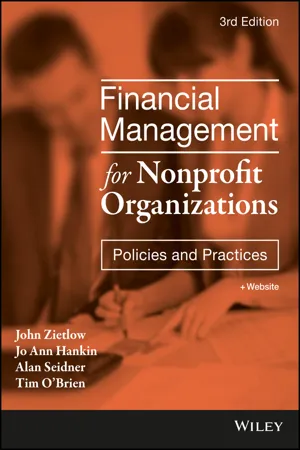
Financial Management for Nonprofit Organizations
Policies and Practices
- English
- ePUB (mobile friendly)
- Available on iOS & Android
Financial Management for Nonprofit Organizations
Policies and Practices
About this book
Essential tools and guidance for effective nonprofit financial management
Financial Management for Nonprofit Organizations provides students, professionals, and board members with a comprehensive reference for the field. Identifying key objectives and exploring current practices, this book offers practical guidance on all major aspects of nonprofit financial management. As nonprofit organizations fall under ever-increasing scrutiny and accountability, this book provides the essential knowledge and tools professional need to maintain a strong financial management system while serving the organization's stated mission. Financial management, cash flow, and financial sustainability are perennial issues, and this book highlights the concepts, skills, and tools that help organizations address those issues. Clear guidance on analytics, reporting, investing, risk management, and more comprise a singular reference that nonprofit finance and accounting professionals and board members should keep within arm's reach.
Updated to reflect the post-recession reality and outlook for nonprofits, this new edition includes new examples, expanded tax-exempt financing material, and recession analysis that informs strategy going forward.
- Articulate the proper primary financial objective, target liquidity, and how it ensures financial health and sustainability
- Understand nonprofit financial practices, processes, and objectives
- Manage your organization's resources in the context of its mission
- Delve into smart investing and risk management best practices
- Manage liquidity, reporting, cash and operating budgets, debt and other liabilities, IP, legal risk, internal controls and more
- Craft appropriate financial policies
Although the U.S. economy has recovered, recovery has not addressed the systemic and perpetual funding challenges nonprofits face year after year. Despite positive indicators, many organizations remain hampered by pursuit of the wrong primary financial objective, insufficient funding and a lack of investment in long-term sustainability; in this climate, financial managers must stay up-to-date with the latest tools, practices, and regulations in order to serve their organization's interests. Financial Management for Nonprofit Organizations provides clear, in-depth reference and strategy for navigating the expanding financial management function.
Frequently asked questions
- Essential is ideal for learners and professionals who enjoy exploring a wide range of subjects. Access the Essential Library with 800,000+ trusted titles and best-sellers across business, personal growth, and the humanities. Includes unlimited reading time and Standard Read Aloud voice.
- Complete: Perfect for advanced learners and researchers needing full, unrestricted access. Unlock 1.4M+ books across hundreds of subjects, including academic and specialized titles. The Complete Plan also includes advanced features like Premium Read Aloud and Research Assistant.
Please note we cannot support devices running on iOS 13 and Android 7 or earlier. Learn more about using the app.
Information
CHAPTER 1
UNDERSTANDING NONPROFIT ORGANIZATION FINANCES
- 1.1 THE IMPACT OF THE GREAT RECESSION
- 1.2 DEFINITION OF NONPROFIT ORGANIZATIONS
- (a) 501(C)(3) Corporations
- (b) Bylaws and Articles of Incorporation
- 1.3 CHARACTERISTICS OF NONPROFIT ORGANIZATIONS
- (a) Organizational Mission
- (b) Organizational Structure
- 1.4 UNDERSTANDING THE LANGUAGE OF THE NONPROFIT ORGANIZATION
- 1.5 FINANCIAL POLICIES
- 1.6 FINANCIAL PRACTICES
- 1.7 PRIMARY FINANCIAL OBJECTIVE
- (a) Differences Between Businesses and Donative Nonprofits
- (b) Survey Evidence on the Primary Financial Objective
- (c) Financial Objective for Purely Financial Decisions
- (d) Recommended Primary Financial Objective: Appropriate Liquidity Target
- 1.8 CONCLUSION
- APPENDIX 1A: THE LILLY STUDY FINDINGS
- There are 1.57 million tax-exempt organizations of which over 1.1 million are public charities (2017).
- In 2013, public charities reported $1.73 trillion in total revenue and $1.63 trillion in total expenses.
- In 2013, public charities reported over $3 trillion in total assets.
- Charitable contributions from individuals, corporations, foundations, and bequests in 2014 were $358.4 billion (an increase of 7.1 percent over 2013).1
As organizations deal with the fluctuations in their sources of funding, having an understanding of the need for financial flexibility has taken on increased significance, and financially literate managers can help their organizations craft sound strategies and objectives that will keep their organizations not only afloat, but thriving during temporary economic declines (Moody's 2012, 38).2
1.1 THE IMPACT OF THE GREAT RECESSION
- In all subsectors, organizational closure was more prevalent during the recession period than during the baseline period.
- In both time periods and across all subsectors, smaller organizations (revenues of between $50,000 and $99,999) were most vulnerable to closure.
- The largest increase in closure rates was in international organizations, while human services experienced the least increase.
- In addition to higher closure rates, the recession is also associated with loss of revenue among smaller nonprofits. Eight percent of all organizations with $50,000 to $99,999 in revenue in 2004 had revenue fall below $50,000 in 2008. That share jumped to 11 percent for the 2008 12-month period.3
- While this study did not directly state that organizations without sufficient liquidity did not do well, it could be considered a safe assumptions that in an era when revenues and liquidity were constrained, many did not survive.
Table of contents
- COVER
- TITLE PAGE
- TABLE OF CONTENTS
- ABOUT THE AUTHORS
- PREFACE
- ACKNOWLEDGMENTS
- CHAPTER 1: UNDERSTANDING NONPROFIT ORGANIZATION FINANCES
- CHAPTER 2: LIQUIDITY MANAGEMENT
- CHAPTER 3: MANAGING MISSION, STRATEGY, AND FINANCIAL LEADERSHIP
- CHAPTER 4: MANAGING STRUCTURE, ACCOUNTABILITY, AND ETHICS
- CHAPTER 5: DEVELOPING FINANCIAL POLICIES
- CHAPTER 6: UNDERSTANDING FINANCIAL ACCOUNTING BASICS AND FINANCIAL STATEMENTS
- CHAPTER 7: DEVELOPING FINANCIAL REPORTS AND RATIOS: MAKING SENSE OF THE NUMBERS
- CHAPTER 8: DEVELOPING OPERATING AND CASH BUDGETS
- CHAPTER 9: LONG-RANGE FINANCIAL PLANNING AND CAPITAL BUDGETING
- CHAPTER 10: MANAGING YOUR ORGANIZATION'S LIABILITIES
- CHAPTER 11: CASH MANAGEMENT AND BANKING RELATIONS
- CHAPTER 12: INVESTMENT POLICY AND GUIDELINES
- CHAPTER 13: INFORMATION TECHNOLOGY AND KNOWLEDGE MANAGEMENT
- CHAPTER 14: MANAGING RISK, LEGAL ISSUES, AND HUMAN RESOURCES
- CHAPTER 15: EVALUATING YOUR POLICIES AND PROGRESS
- INDEX
- END USER LICENSE AGREEMENT